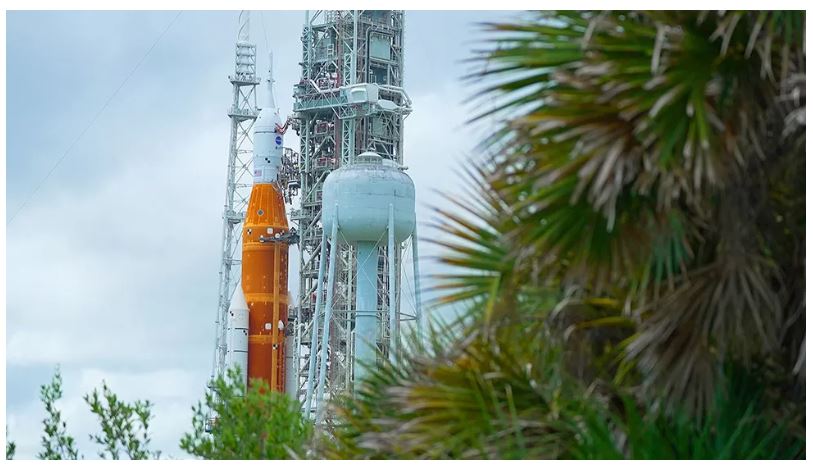SOURCE: BBC — The US space agency has had to postpone the launch of its new Artemis I Moon rocket for the second time in a week.
Controllers were unable to stop a hydrogen leak on the vehicle, almost from the start of Saturday’s countdown procedure.
Nasa now has another opportunity to launch the rocket on Monday or Tuesday.
After that the vehicle will have to return to its assembly building for inspection and maintenance, which will mean further delays.
The Space Launch System is the most powerful rocket ever developed by Nasa, and much of the enormous thrust comes from burning almost three million litres of super-cold liquid hydrogen and oxygen in four big engines on the vehicle’s underside.
But when controllers sent the early morning command to fill the rocket’s hydrogen tank, an alarm went off, indicating there was a leak.
The problem was traced to the connection where the hydrogen was being pumped into the vehicle.
Controllers tried a number of fixes, including allowing the hardware to warm up for short periods, hoping this might reset the seal. But without success.
It’s possible Nasa could try again in the next few days. But if the rocket needs to be rolled back to the engineering building for further work this will introduce several weeks of delay.
Saturday’s attempt to despatch the Space Launch System (SLS) rocket had been scheduled for the start of a two-hour window beginning at 14:17 local time (19:17 BST; 18:17 GMT).
The 100m-tall vehicle’s objective was to hurl a human-rated capsule in the direction of the Moon, something that hasn’t happened since Project Apollo ended in 1972.
Nasa first tried to launch SLS on Monday, but that bid was ultimately scrubbed because controllers couldn’t be sure the four big engines under the rocket’s core-stage were properly prepared for flight.
This will put the upper-stage of the rocket, with the Orion capsule still attached, into a highly elliptical orbit that would see the two of them come crashing back to Earth without any further effort.
So, the upper-stage will have to raise and circularise the orbit before then boosting Orion in the direction of the Moon.
Confirmation that the capsule is on its own, on track and speeding through space at 30,000 km/h (19,000mph) should come two hours and five minutes after launch.
The planned mission length is just under 38 days. This would result in Orion returning to Earth for a splashdown in the ocean off San Diego in California on 11 October.
Thirty-eight days is much longer than the 21 days that capsule manufacturer Lockheed Martin says is the maximum time astronauts should spend in the spacecraft.
But Annette Hasbrook, senior advisor on the Orion programme at Nasa, said engineers wanted to stretch the spacecraft on this mission to understand its limits.
The shuttle-era power units are chilled during countdown to -250C to prevent them being shocked by the sudden injection of cryogenic propellants at the moment of launch. But a sensor was indicating that Engine No 3 might be 15-30 degrees short of where its temperature needed to be.
When the SLS does get away, it is sure to be a spectacular sight.
“It’s gonna be ‘shuttle on steroids’,” said Doug Hurley, who was the pilot on the very last shuttle mission in 2011.
The former astronaut now works for Northrop Grumman who make the big white solid boosters on the sides of the SLS.
“What I always thought was the coolest thing about shuttle launches was you saw it lift off and it was well clear of the tower before you heard anything, and then it was even a little longer before you felt it,” he explained.
“Thrust to weight-wise, SLS is pretty close to what shuttle was. Apollo’s Saturn V rocket was drastically different. I never saw it in person but it lumbered clear of the pad. For shuttle, it seemed like it was clear in an instant, almost as soon as the boosters were lit. SLS should be the same,” he told BBC News.
“You’re trying to test the edges of your boxes, not your nominal profile,” she explained.




